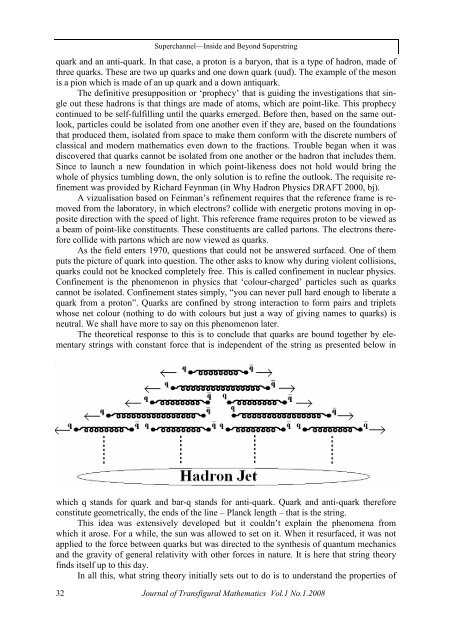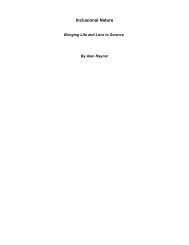JTfM Vol 1 No 1 2008 - ONLINE EDITION - Inclusionality Research
JTfM Vol 1 No 1 2008 - ONLINE EDITION - Inclusionality Research
JTfM Vol 1 No 1 2008 - ONLINE EDITION - Inclusionality Research
Create successful ePaper yourself
Turn your PDF publications into a flip-book with our unique Google optimized e-Paper software.
Superchannel—Inside and Beyond Superstring<br />
quark and an anti-quark. In that case, a proton is a baryon, that is a type of hadron, made of<br />
three quarks. These are two up quarks and one down quark (uud). The example of the meson<br />
is a pion which is made of an up quark and a down antiquark.<br />
The definitive presupposition or ‘prophecy’ that is guiding the investigations that single<br />
out these hadrons is that things are made of atoms, which are point-like. This prophecy<br />
continued to be self-fulfilling until the quarks emerged. Before then, based on the same outlook,<br />
particles could be isolated from one another even if they are, based on the foundations<br />
that produced them, isolated from space to make them conform with the discrete numbers of<br />
classical and modern mathematics even down to the fractions. Trouble began when it was<br />
discovered that quarks cannot be isolated from one another or the hadron that includes them.<br />
Since to launch a new foundation in which point-likeness does not hold would bring the<br />
whole of physics tumbling down, the only solution is to refine the outlook. The requisite refinement<br />
was provided by Richard Feynman (in Why Hadron Physics DRAFT 2000, bj).<br />
A vizualisation based on Feinman’s refinement requires that the reference frame is removed<br />
from the laboratory, in which electrons? collide with energetic protons moving in opposite<br />
direction with the speed of light. This reference frame requires proton to be viewed as<br />
a beam of point-like constituents. These constituents are called partons. The electrons therefore<br />
collide with partons which are now viewed as quarks.<br />
As the field enters 1970, questions that could not be answered surfaced. One of them<br />
puts the picture of quark into question. The other asks to know why during violent collisions,<br />
quarks could not be knocked completely free. This is called confinement in nuclear physics.<br />
Confinement is the phenomenon in physics that ‘colour-charged’ particles such as quarks<br />
cannot be isolated. Confinement states simply, “you can never pull hard enough to liberate a<br />
quark from a proton”. Quarks are confined by strong interaction to form pairs and triplets<br />
whose net colour (nothing to do with colours but just a way of giving names to quarks) is<br />
neutral. We shall have more to say on this phenomenon later.<br />
The theoretical response to this is to conclude that quarks are bound together by elementary<br />
strings with constant force that is independent of the string as presented below in<br />
which q stands for quark and bar-q stands for anti-quark. Quark and anti-quark therefore<br />
constitute geometrically, the ends of the line – Planck length – that is the string.<br />
This idea was extensively developed but it couldn’t explain the phenomena from<br />
which it arose. For a while, the sun was allowed to set on it. When it resurfaced, it was not<br />
applied to the force between quarks but was directed to the synthesis of quantum mechanics<br />
and the gravity of general relativity with other forces in nature. It is here that string theory<br />
finds itself up to this day.<br />
In all this, what string theory initially sets out to do is to understand the properties of<br />
32<br />
Journal of Transfigural Mathematics <strong>Vol</strong>.1 <strong>No</strong>.1.<strong>2008</strong>




